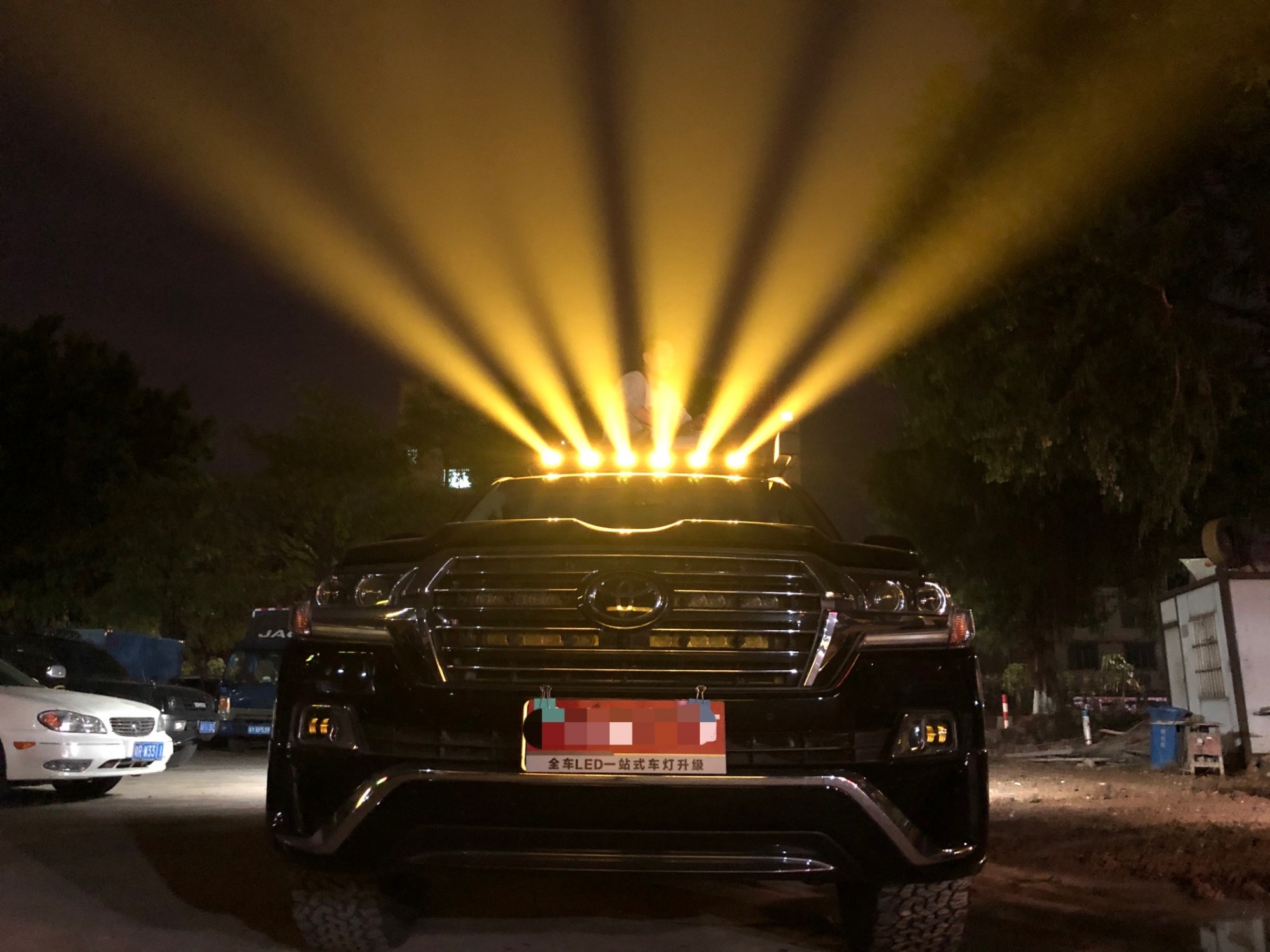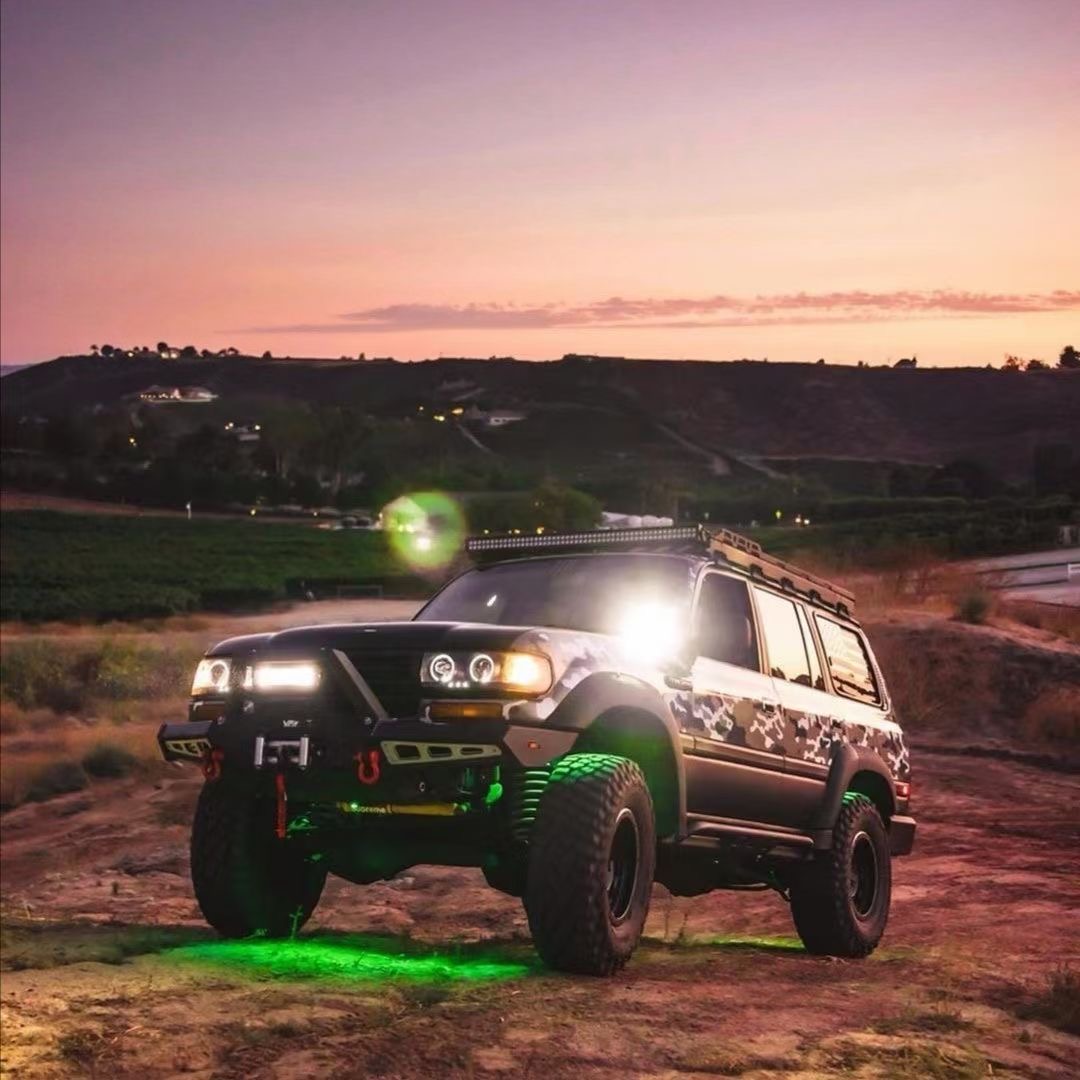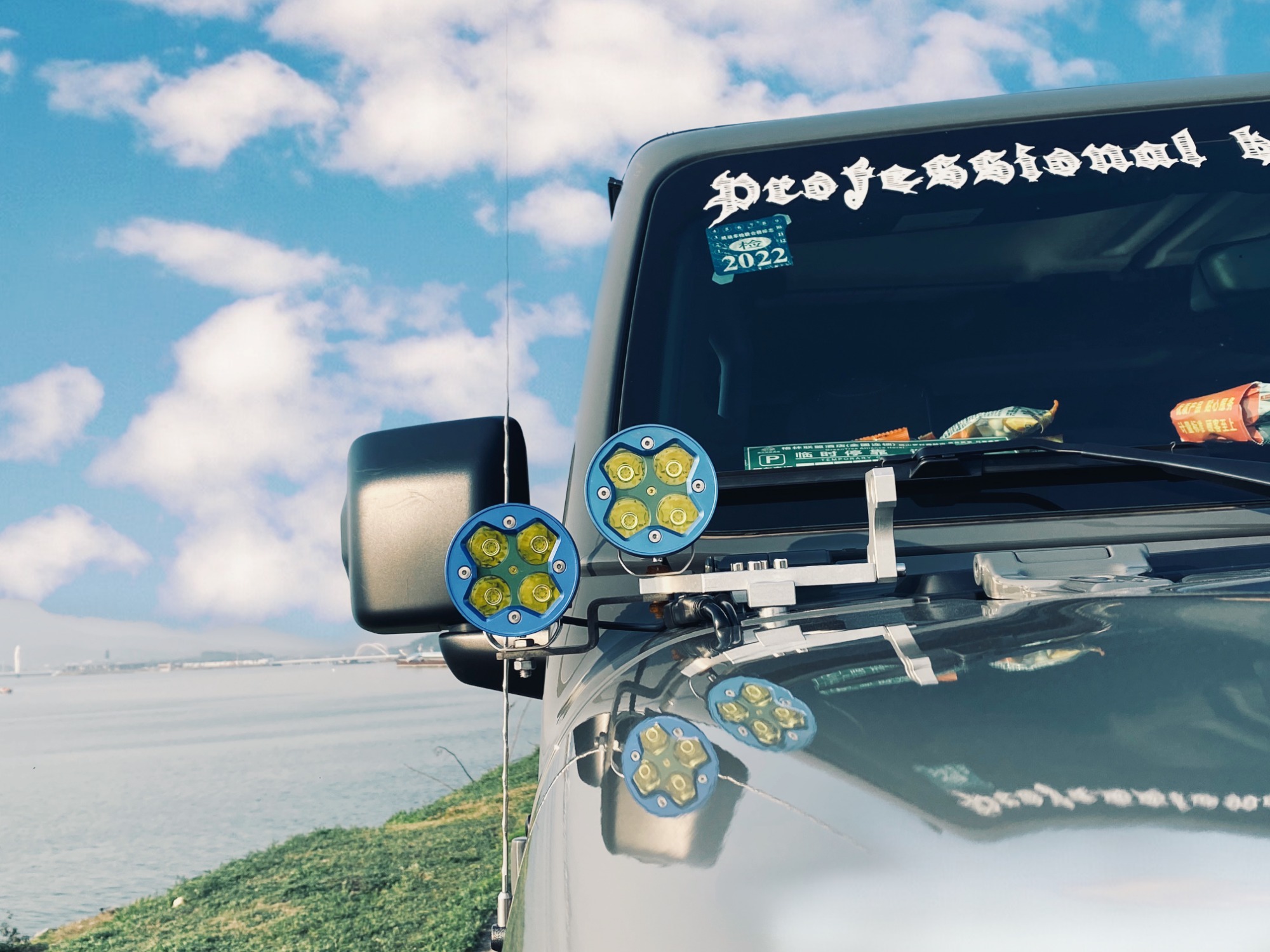By Carol | 20 July 2021 | 0 Comments
Light up the eyes of the night: precautions for light modification of off-road vehicles (part 1)
Three factors that determine the effect of auxiliary lights: power, size and coating quality
There is no need to distinguish the order of these. The "cause" is different, the "effect" is different. Under the premise of similar light sources and coatings, power is a prerequisite for determining brightness, but the power cannot be increased indefinitely. This is because the headlights are a configuration that consumes more power in the car. The power of the modified headlights that year is generally One for 100-130w, four for four to five hundred watts. The power of automobile generators, the thickness of wires, and the conductivity of relays are limited, so the brightness cannot be increased by power uncontrollably.
In fact, it’s meaningless to increase the brightness excessively. For example, it’s useless if you turn on 10,000 auxiliary lights under the intensity of daylight, because the intensity and brightness of the sun’s light have reached the saturation of your eyes, and it doesn’t make sense to increase the number of spotlights. . There are a lot of floating dust in the air in most parts of the country, and the auxiliary lamp that is too bright will cause very serious diffraction reflection. The beam of light caused by the auxiliary lamp will seriously interfere with your observation effect, and you may not be able to see the road conditions.

The importance and difference of auxiliary lamp coating
In addition to the diameter of the light reflector bowl and the characteristics of the luminous body-power, which determine the brightness of the auxiliary lamp, the material of the lamp surface coating is also a very important part; chrome plating, aluminum plating or other things, its reflection efficiency It is different, so the illumination effect of the headlights of the same size may be completely different. In addition, the quality of the coating directly determines the use effect and life of the headlights.
Poor quality coatings are easy to turn black, which will result in lower reflection efficiency of the headlights and reduced illumination effects, and blackened coatings will cause the next round of vicious circle until the coating finally peels off and falls off. In the past, many shoddy domestic auxiliary lights were commonplace.

The difference and influence of color temperature
What is the color temperature? Anyone who has learned the basics of digital photography will know very well and understand the importance of white temperature for filming; but the role of auxiliary lamp color temperature is completely different from photography, but the correct color temperature of car headlights is equally important.
To briefly talk about the choice of auxiliary lamp color temperature, try to consider about 4300-5000k. If it is not in this range, then no matter how high or low the color temperature is, it is easy to produce a "dyeing effect"; for example, 6000k lights are whitish and blue. When you reach other color temperature lights, such as yellowish street lights, the color of your lights will be "dyed", thus losing the lighting effect. At the same time, when the high color temperature encounters a dusty environment in the wild, the light will be very dusty. It is easy to cause strong reflection and affect the line of sight and observation effect.

If the color temperature is low, such as the golden eye (about 3000k color temperature) that was very popular in the past few years, then the color of all objects it irradiates will become 3000k, and this color temperature is not the color temperature of daylight, that is, we can distinguish the "true color" of the object. The color temperature-this will seriously reduce the recognizability of the object, because the illuminated object has been "stained", it will be easier to see the shape and characteristics of the object after a longer time, and it will also accelerate the process of eye fatigue .
Therefore, when choosing the color temperature of the auxiliary lamp, we must pay attention to the above two points. They usually cause a lot of problems inadvertently, which may affect the driving safety, so we must pay more attention.

Sight and distance: your ability to recognize
How far you can see clearly at night is very important. In most cases, auxiliary lights that shine too far are meaningless to you, because you don’t know what it is; for example, you don’t know what it is when you are 200 meters away. It is impossible to distinguish obstacles when moving at high speeds, especially objects attached to the horizon-such as a brick, and these small things often have very serious consequences for you.
In addition, a large number of traffic facilities, road signs, other obstacles and road curves will also affect your effective visual distance; therefore driving in the dark, especially off-road driving, no matter how bright the auxiliary lights are, control the speed within your own ability range Inside are the most important.

The resolution of most people’s eyes is at night no matter how strong the light aid is, because the night siphon and tunnel benefits (drunk driving will be very obvious), plus more importantly, the light exposure is different from the sun; the sun exposure area The approximate cross-section that covers the entire earth, although there are forward light and back light, is generally diffuse light.
There will be light reflections around an object, but the light is completely different. It can only be illuminated from one angle. Therefore, after illuminating the object, it can only reflect back to the side of the object facing the light, but not illuminated. The back and sides that are reached have a very large light ratio compared to the front. This light ratio tends to change its truth, which is often quite misleading to the judgment of the human eye.

There is another more important point, which is that the "object outline" reflected by the light is not true color (this may not be easy for everyone to understand, you compare the difference between the same object under daylight and sunlight, its color recognition, object There will be obvious gaps in contour definition); in this case, the recognition ability of the human eye will be greatly reduced.
There is no need to distinguish the order of these. The "cause" is different, the "effect" is different. Under the premise of similar light sources and coatings, power is a prerequisite for determining brightness, but the power cannot be increased indefinitely. This is because the headlights are a configuration that consumes more power in the car. The power of the modified headlights that year is generally One for 100-130w, four for four to five hundred watts. The power of automobile generators, the thickness of wires, and the conductivity of relays are limited, so the brightness cannot be increased by power uncontrollably.
In fact, it’s meaningless to increase the brightness excessively. For example, it’s useless if you turn on 10,000 auxiliary lights under the intensity of daylight, because the intensity and brightness of the sun’s light have reached the saturation of your eyes, and it doesn’t make sense to increase the number of spotlights. . There are a lot of floating dust in the air in most parts of the country, and the auxiliary lamp that is too bright will cause very serious diffraction reflection. The beam of light caused by the auxiliary lamp will seriously interfere with your observation effect, and you may not be able to see the road conditions.

The importance and difference of auxiliary lamp coating
In addition to the diameter of the light reflector bowl and the characteristics of the luminous body-power, which determine the brightness of the auxiliary lamp, the material of the lamp surface coating is also a very important part; chrome plating, aluminum plating or other things, its reflection efficiency It is different, so the illumination effect of the headlights of the same size may be completely different. In addition, the quality of the coating directly determines the use effect and life of the headlights.
Poor quality coatings are easy to turn black, which will result in lower reflection efficiency of the headlights and reduced illumination effects, and blackened coatings will cause the next round of vicious circle until the coating finally peels off and falls off. In the past, many shoddy domestic auxiliary lights were commonplace.

The difference and influence of color temperature
What is the color temperature? Anyone who has learned the basics of digital photography will know very well and understand the importance of white temperature for filming; but the role of auxiliary lamp color temperature is completely different from photography, but the correct color temperature of car headlights is equally important.
To briefly talk about the choice of auxiliary lamp color temperature, try to consider about 4300-5000k. If it is not in this range, then no matter how high or low the color temperature is, it is easy to produce a "dyeing effect"; for example, 6000k lights are whitish and blue. When you reach other color temperature lights, such as yellowish street lights, the color of your lights will be "dyed", thus losing the lighting effect. At the same time, when the high color temperature encounters a dusty environment in the wild, the light will be very dusty. It is easy to cause strong reflection and affect the line of sight and observation effect.

If the color temperature is low, such as the golden eye (about 3000k color temperature) that was very popular in the past few years, then the color of all objects it irradiates will become 3000k, and this color temperature is not the color temperature of daylight, that is, we can distinguish the "true color" of the object. The color temperature-this will seriously reduce the recognizability of the object, because the illuminated object has been "stained", it will be easier to see the shape and characteristics of the object after a longer time, and it will also accelerate the process of eye fatigue .
Therefore, when choosing the color temperature of the auxiliary lamp, we must pay attention to the above two points. They usually cause a lot of problems inadvertently, which may affect the driving safety, so we must pay more attention.

Sight and distance: your ability to recognize
How far you can see clearly at night is very important. In most cases, auxiliary lights that shine too far are meaningless to you, because you don’t know what it is; for example, you don’t know what it is when you are 200 meters away. It is impossible to distinguish obstacles when moving at high speeds, especially objects attached to the horizon-such as a brick, and these small things often have very serious consequences for you.
In addition, a large number of traffic facilities, road signs, other obstacles and road curves will also affect your effective visual distance; therefore driving in the dark, especially off-road driving, no matter how bright the auxiliary lights are, control the speed within your own ability range Inside are the most important.

The resolution of most people’s eyes is at night no matter how strong the light aid is, because the night siphon and tunnel benefits (drunk driving will be very obvious), plus more importantly, the light exposure is different from the sun; the sun exposure area The approximate cross-section that covers the entire earth, although there are forward light and back light, is generally diffuse light.
There will be light reflections around an object, but the light is completely different. It can only be illuminated from one angle. Therefore, after illuminating the object, it can only reflect back to the side of the object facing the light, but not illuminated. The back and sides that are reached have a very large light ratio compared to the front. This light ratio tends to change its truth, which is often quite misleading to the judgment of the human eye.

There is another more important point, which is that the "object outline" reflected by the light is not true color (this may not be easy for everyone to understand, you compare the difference between the same object under daylight and sunlight, its color recognition, object There will be obvious gaps in contour definition); in this case, the recognition ability of the human eye will be greatly reduced.
Leave a Reply
Your email address will not be published.Required fields are marked. *
CATEGORIES